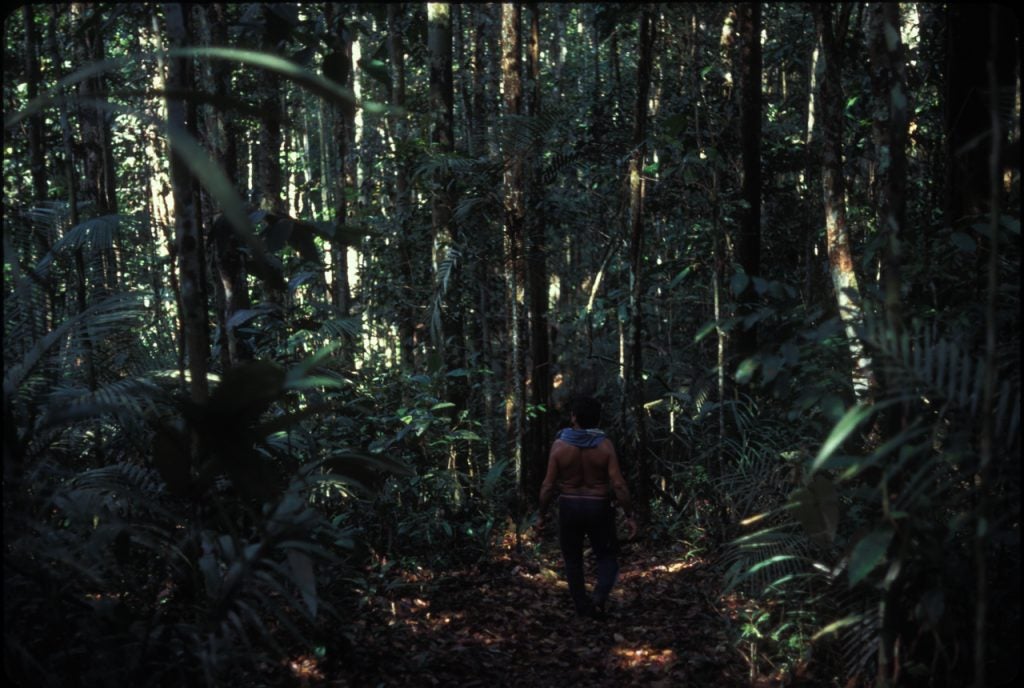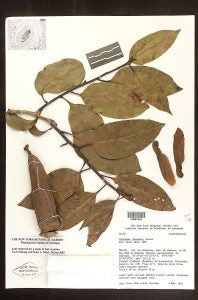Summary: The Brazil nut family – Lecythidaceae – is one of the most important families of trees in the Amazon basin. Yet compared to tree families of temperate forests, the group is extremely understudied. In collaboration with Brazilian colleagues, our lab has selected neotropical Lecythidaceae as a model clade for integrated studies of systematics, ecology and evolution in Amazon trees. This post summarizes a few interesting features of the group, and describes plans to revive a Lecythidaceae research project near Manaus, Brazil.

Lecythidaceae is one of the most important Amazon tree families in terms of cultural, ecological and economic value. Its species include the iconic Brazil nut tree Bertholletia excelsa; the oldest documented angiosperm trees (e.g., a Cariniana micrantha C-dated at >1400 years old; Chambers et al. 1998); and the cannonball tree Couroupita guianensis. Eschweilera is the most abundant tree genus in Amazon forests (ter Steege et al. 2016), and E. coriacea may be the most abundant tree species within the vast Amazon basin (ter Steege et al. 2013).
Lecythidaceae, sensu lato, is a pantropical clade nested within the order Ericales. The Neotropical clade, which is recognized either as subfamily Lecythidoideae or simply as Lecythidaceae sensu strictu, contains 10 genera and approximately 216 species (Mori et al. 2017). Most of the species are found in lowland rain forest, although some species are adapted to tropical montane forest, flooded forests (igapó and várzea), and savanna. Fossils dating back to the late Cretaceous (summarized by Mori et al 2017) indicate that the family is as old as the neotropical rain forest biome itself (Graham 2013). Amazonia is the epicenter of Lecythidaceae diversity.
For a temperate zone analogy, I think of North American Fagaceae, with its 97 tree species from 5 genera, including the chestnuts (Castanea), beech (Fagus), and oaks (Quercus). Only Quercus is notably diverse, with ca. 90 American species. Both families contain iconic, long-lived trees with fine woods and useful seed crops. However, there is a glaring disparity in research effort on the two families. A Web of Science search on the two most diverse Lecythidaceae genera pulls up 78 (Eschweilera, ca. 100 spp.) and 91 (Lecythis, ca. 30 spp.) publications. In comparison, there are 18,257 and 8,032 citations for Quercus and Fagus, respectively. Fully annotated genomes exist for Quercus, Fagus, and Castanea, whereas only a scattering of chloroplast and nuclear ITS DNA sequences are available for Lecythidaceae.
Clearly there is much work to be done on the Brazil nut group. Our lab is especially interested in what we can learn from the family regarding areas of clade endemism in the Amazon basin, ecological niche evolution, population genetic structure, and biogeographic history, in addition to more clade-specific research on evolutionary relationships, species boundaries, and new species discovery.
Resurrecting the Km 41 Lecythidaceae plot

My introduction to Amazon forests and Lecythidaceae occurred in 1992, when I had an internship as a botanical collector in the Biological Dynamics of Forest Fragments Project (BDFFP) under the supervision of Mike Nee of the New York Botanical Garden (NYBG)
On occasion I visited the vast and relatively pristine forest at camp Km 41, so named because of its location 41 km east of the Manaus-Boa Vista highway. The camp was situated in a sandy clearing near a blackwater stream. Its old growth forest extended for 300 km north to the Venezuelan border. At that time a group of Brazilian students were working on a major study of the Lecythidaceae under the supervision of NYBG botanist Scott Mori.
The Lecythidaceae subproject began in 1987, when Peter Becker (ecologist) approached Mori (taxonomist) about collaboration. “Becker was interested in the dynamics of tropical forests and therefore was looking for a family of tropical trees that met three criteria: high diversity, high density, and relatively well-known taxonomy.” (Mori & da Cunha, 1995, p. 3). Mori, on the other hand, who had just finished a taxonomic and ecological study of Lecythidaceae in central French Guiana, was looking to expand his studies into central Amazonia, where diversity of Lecythidaceae is high and where there were numerous taxonomic problems yet to be solved. At the heart of the Lecythidaceae subproject was a 100 ha (= 247 acres) forest inventory plot, in which all Lecythidaceae trees ≥10 cm diameter at breast height (dbh) were measured and mapped in 1989-90.
The km 41 plot — equivalent in area to 147 U.S. football fields — contained 39 Lecythidaceae species and 7791 individual trees; Eschweilera coriacea was the most abundant species, with 1539 individuals. Of the 39 species in the plot, 30% (13 spp.) were described since 1978; 3 species were new to science (Lecythis gracieana [n = 40], Eschweilera romeu-cardosoi [n = 309] and E. rankiniae [n = 16]) were discovered in the plot. Scott recognized two additional new species (“Lecythis 01” [n = 8] and “Lecythis 05” [n = 51]) on the basis of field characters, but didn’t formally name them for lack of flower specimens (which we hope to collect this year).
There have been no follow-up measurements of tree growth, recruitment or mortality to assess demographic turnover. In addition, 25 ha of the Lecythidaceae plot were intensively surveyed for palms (coordinated by Andrew Henderson, NYBG) and Sapotaceae (Wilson Spironello, INPA, and Terry Pennington, Kew). The palm and Sapotaceae data were never published. Alexandre Oliveira and Scott Mori (1998) published a comprehensive tree inventory of 3 ha of the plot, which showed high species diversity comparable to the western Amazon.
Research subprojects (current)
Phylogeny – We want to resolve the major clades of Lecythidaceae and this will probably result in a generic level reclassification, because it is clear that the two largest genera Lecythis and Eschweilera are polyphyletic. Robust phylogenetic analyses necessitate the use of novel genetic markers. To this end, the first post-doc on this project, Ashley Thompson, sequenced entire chloroplast genomes of 24 Lecythidaceae species. In collaboration with current post-doc Oscar Vargas, they have analyzed these data in a phylogenetic context to identify DNA markers for population genetics, DNA barcoding and phylogeny (Thomson, Vargas and Dick in prep).
With supervision of EEB collaborator Stephen Smith and additional transcriptome data provided by Myriam Heuertz of INRA-Bordeaux, Oscar is developing baits for targeted sequence capture using high throughput sequencing. Oscar is on track to analyze samples from the Km 41 species, along with DNA from herbarium specimens, in the next months.
Species delimitation – EEB Grad student Drew Larson will be testing the taxonomic delimitation of species at Km 41 with RADSeq data. The questions — are all the species Scott described “good” (i.e. genetically cohesive) species? Are there cryptic species among any of the polymorphic species? Is there evidence of hybridization/introgression among the more closely related species? The latter question will be done in parallel with a study led by collaborator Myriam Heuertz in French Guiana.
Flood ecology in terra firme – EEB Grad student Tamara Milton is interested in how periodic flooding events in the upland (terra firme) forests impact tree demography. In particular, she wants to revisit parts of the km 41 plot that were flooded nearly 30 years ago (Mori & Becker, 1991) to determine if flooding events significantly altered patterns of Lecythidaceae abundance. Her hypothesis is that flood tolerance of E. coriacea contributes to its hyperdominance.
Cryptic diversity in Eschweilera coriacea – Priscila Souza has proposed to tackle the question of cryptic species diversity in E. coriacea as part of her PhD research at INPA. Based on field observations and discussions with Scott Mori, it appears likely that E. coriacea is a species complex. This project will require geographic sampling beyond the confines of the Km 41 plot. Priscila is advised by collaborator Alberto (Beto) Vicentini.
Macro-evolution of flood-tolerance – BDFFP alumnus Bruno Garcia Luize is interested in habitat shifts of Lecythidaceae between terra firme and wetlands. He will examine the wetland distribution as a trait within a family-level phylogeny to determine the timing and frequency of flood tolerance. Bruno will work with us in Manaus, and visit the University of Michigan to learn the biogeographic analyses. Bruno is a PhD student in Thiago Silva’s lab at USP/Rio Claro.
Funding and collaboration
Scott Mori and I obtained funding to collaboratively study Lecythidaceae phylogeny and biogeography through an NSF/FAPESP Dimensions of Biodiversity Project led by Joel Cracraft and Lúcia Lohmann. Lúcia subsequently sponsored me for a CAPES Ciência sem Fronteiras (Science without Borders) Pesquisador Visitante Especial (PVE) fellowship, which allowed me to obtain a Brazilian research visa. BDFFP Director José Luís Camargo helped me with a BDFFP research proposal and José Luís and Beto helped me to obtain permits needed for the genetic work. Alexandre Oliveira provided plot data for Lecythidaceae; Andrew Henderson provided palm census data, and Wilson Spironello provided data for the Sapotaceae.

Literature Cited
Chambers JQ, Higuchi N, Schimel JP. 1998. Ancient trees in Amazonia. Nature 391: 135–136.
De Oliveira, A. A. and S. A. Mori (1999). A central Amazonian terra firme forest. I. High tree species richness on poor soils. Biodiversity and Conservation 8(9): 1219-1244.
Graham A. (2013) A Natural History of the New World: The Ecology and Evolution of Plants in the Americas. University Of Chicago Press. 408 pages.
Mori, S. A. and P. Becker (1991). Flooding affects survival of Lecythidaceae in terra firme forest near Manaus, Brazil. Biotropica 23(1): 87-90.
Mori, S.A., E.A. Kiernan, N.P. Smith, L.M. Kelley, Y-Y. Huang, G.T. Prance & B. Thiers. 2017. Observations on the phytogeography of the Lecythidaceae clade (Brazil nut family). Phytoneuron 30: 1–85. ISSN 2153 733X (open access link)
ter Steege H, Pitman NCA, Sabatier D, Baraloto C, Salomão RP, Guevara JE, Phillips OL, Castilho CV, Magnusson WE, Molino JF, et al. 2013. Hyperdominance in the Amazonian tree flora. Science 342: 1243092.
ter Steege H, Vaessen RW, Cárdenas-López D, Sabatier D, Antonelli A, de Oliveira SM, Pitman NCA, Jørgensen PM, Salomão RP, Silva JMC Da, et al. 2016. The discovery of the Amazonian tree flora with an updated checklist of all known tree taxa. Scientific Reports 6: 29549. (open access link)
Other Resources
Angiosperm Phylogeny Group (APG) website curated by Peter Stevens provides an overview of Lecythidaceae sensu lato and its placement within the Ericales
Scott Mori’s Lecythidaceae Pages are the authoritative source for literature, taxonomy, and resources associated with the family.
Rogério Gribel has produced some videos focused on Brazil nut conservation and pollination
Check out the twitter hashtag #Lecythidaceae
One thought to “Resurrecting an Amazon forest inventory of the Brazil nut family (Lecythidaceae)”
Comments are closed.